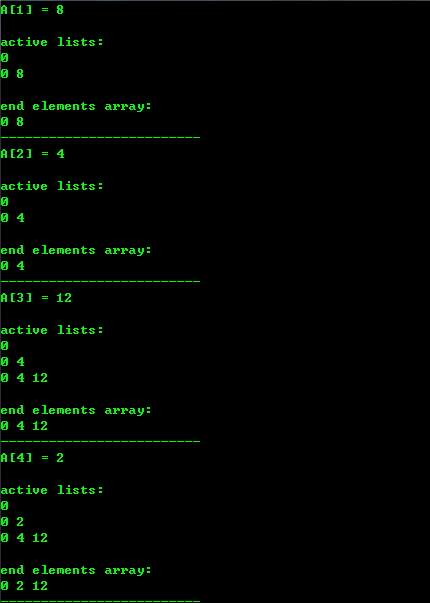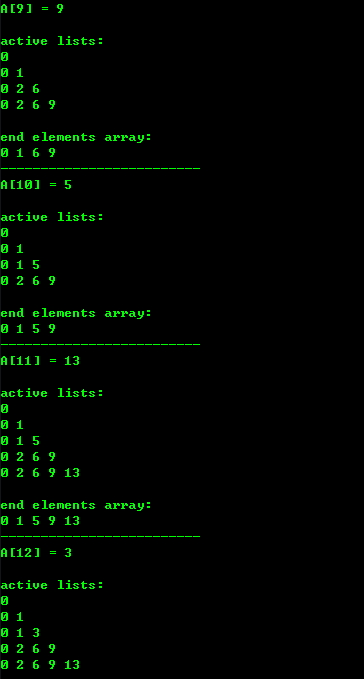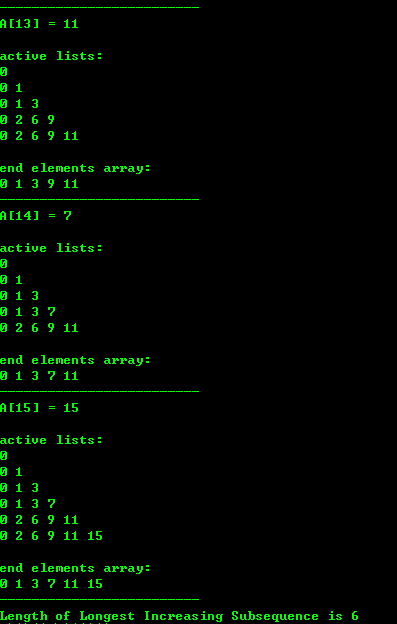Longest Increasing Subsequences(最长递增子序列)的两种DP实现
/**
@description: Longest Increasing Subsequence
@author: seiyagoo
@create: 2013.10.25
@modified: 2013.10.26
**/
int LIS_1(int A[], int size){ int *LIS = new int[size];
vector<int> *vec = new vector<int>[size]; /* Compute optimized LIS values in bottom up manner */
for(int i=; i < size; i++){
LIS[i]=; //初始化默认长度
int max_j=, flag=;
for(int j=; j < i; j++){ //查表,找出前面最长的序列, 若将A[i]加入LIS[j](LIS[j]+1的含义)的递增子序列比当前的LIS[i]更长, 则更新LIS[i]
if(A[i] > A[j] && LIS[i] < LIS[j]+){
LIS[i] = LIS[j]+;
max_j=j;
flag=;
}
}
if(flag) //copy前面最长子序列到vec[i]
vec[i].insert(vec[i].end(), vec[max_j].begin(), vec[max_j].end());
vec[i].push_back(A[i]); //最后放入A[i]
} /*Show LIS of the current state*/
vector<int>::iterator it;
cout<<left;
for(int i=; i<size; i++){
cout<<setw()<<A[i]<< " --> ";
for(it = vec[i].begin(); it!=vec[i].end(); it++)
cout<<*it<<" ";
cout<<endl;
} /* Pick maximum of all LIS values, namely max{LIS[i]} */
int max_len=;
for(int i = ; i < size; i++ )
if( max_len < LIS[i] )
max_len = LIS[i]; delete[] LIS;
delete[] vec; return max_len;
}
/**
@description: Longest Increasing Subsequence
@author: seiyagoo
@create: 2013.10.25
@modified: 2013.10.26
**/ // Binary search (note boundaries in the caller)
// A[] is ceilIndex in the caller
int CeilIndex(int A[], int l, int r, int key) {
int m; while( r - l > ) {
m = l + (r - l)/;
(A[m] >= key ? r : l) = m; // ternary expression returns an l-value
} return r;
} int LIS_2(int A[], int size) {
// boundary case: when array size is one
if( == size ) return ; int *tailTable = new int[size];
vector<int> *vec = new vector<int>[size];
int len; // always points empty slot //memset(tailTable, INT_MAX, sizeof(tailTable[0])*size); @bug for(int i = ; i < size; i++)
tailTable[i] = INT_MAX; tailTable[] = A[]; //tailTable[0] store the smallest value
vec[].push_back(A[]); len = ;
for( int i = ; i < size; i++ ) {
if( A[i] < tailTable[] ) { //case 1: new smallest value
tailTable[] = A[i]; /*discard and create*/
vec[].clear();
vec[].push_back(A[i]);
}
else if( A[i] > tailTable[len-] ) { //case 2: A[i] wants to extend largest subsequence
tailTable[len++] = A[i]; /*clone and extend*/
vec[len-] = vec[len-];
vec[len-].push_back(A[i]);
}
else { //case 3: A[i] wants to be current end candidate of an existing subsequence, It will replace ceil value in tailTable
int ceilIndex = CeilIndex(tailTable, -, len-, A[i]);
tailTable[ceilIndex] = A[i]; /*discard, clone and extend*/
vec[ceilIndex].clear();
vec[ceilIndex] = vec[ceilIndex-];
vec[ceilIndex].push_back(A[i]);
} /*Printf all the active lists*/
vector<int>::iterator it;
cout<<left;
cout<<"A["<<i<<"] = "<<A[i]<<endl<<endl;
cout<<"active lists:"<<endl;
for(int i=; i<len; i++){
for(it = vec[i].begin(); it!=vec[i].end(); it++)
cout<<*it<<" ";
cout<<endl;
} /*Printf end elements of all the active lists*/
cout<<endl<<"end elements array:"<<endl;
for(int i = ; i < size; i++)
if(tailTable[i] != INT_MAX)
cout<<tailTable[i]<<" ";
cout<<endl;
cout<<"-------------------------"<<endl;
} delete[] tailTable;
delete[] vec; return len;
}
五、运行结果
example:





Longest Increasing Subsequences(最长递增子序列)的两种DP实现的更多相关文章
- leetcode300. Longest Increasing Subsequence 最长递增子序列 、674. Longest Continuous Increasing Subsequence
Longest Increasing Subsequence 最长递增子序列 子序列不是数组中连续的数. dp表达的意思是以i结尾的最长子序列,而不是前i个数字的最长子序列. 初始化是dp所有的都为1 ...
- [LintCode] Longest Increasing Subsequence 最长递增子序列
Given a sequence of integers, find the longest increasing subsequence (LIS). You code should return ...
- [LeetCode] Longest Increasing Subsequence 最长递增子序列
Given an unsorted array of integers, find the length of longest increasing subsequence. For example, ...
- 673. Number of Longest Increasing Subsequence最长递增子序列的数量
[抄题]: Given an unsorted array of integers, find the number of longest increasing subsequence. Exampl ...
- [LeetCode] 300. Longest Increasing Subsequence 最长递增子序列
Given an unsorted array of integers, find the length of longest increasing subsequence. Example: Inp ...
- [leetcode]300. Longest Increasing Subsequence最长递增子序列
Given an unsorted array of integers, find the length of longest increasing subsequence. Example: Inp ...
- poj 2533 Longest Ordered Subsequence 最长递增子序列
作者:jostree 转载请注明出处 http://www.cnblogs.com/jostree/p/4098562.html 题目链接:poj 2533 Longest Ordered Subse ...
- [LeetCode] Number of Longest Increasing Subsequence 最长递增序列的个数
Given an unsorted array of integers, find the number of longest increasing subsequence. Example 1: I ...
- POJ 2533 - Longest Ordered Subsequence - [最长递增子序列长度][LIS问题]
题目链接:http://poj.org/problem?id=2533 Time Limit: 2000MS Memory Limit: 65536K Description A numeric se ...
- [LeetCode] 673. Number of Longest Increasing Subsequence 最长递增序列的个数
Given an unsorted array of integers, find the number of longest increasing subsequence. Example 1: I ...
随机推荐
- 解决root登录 -bash-4.2# 的问题
- 阅读笔记—JSP
JSP页面概述 JSP(JavaServer Page)是一种动态页面技术,它在java web应用中主要实现表现逻辑.JSP页面是在HTML页面中嵌入JSP元素的动态Web页面,一般来说JSP页面中 ...
- Swift视频教程,Swift千人学iOS开发编程语言
此时大家站在同一起跑线.Swift语言将将是下一个风靡程序猿界的编程语言,是否能抢占先机,近在咫尺. 本期推荐Swift编程语言视频教程,内容包含:开发环境基本使用.数据类型和常量.数据自己主动检查和 ...
- Android之——短信的备份与还原
转载请注明出处:http://blog.csdn.net/l1028386804/article/details/47091281 眼下,Android手机中的一些软件能够实现手机短信的备份与还原操作 ...
- VBA调试利器debug.print
作者:iamlaosong 百度一下.非常easy找到debug.print解释和使用介绍.事实上非常简单.就是将代码运行结果显示在"马上窗体"中,但不影响程序运行.VBA程序调试 ...
- values-dimen 不同分辨率资源实现引用
今天遇到了一种情况,就是在不同分辨率下面出现了需要设定不同的距离,当时第一反映就是重新定义一个layout.但是,仅仅为了更改一个数值就复制那么多的代码,明显不合里.后来就想到干脆在不同的分辨率下创建 ...
- java中goto语句
goto是java中一个保留字,但在语言中并未使用它. goto语句起源于汇编语言的程序控制,是源码级上的跳跃,这使其招致了不好的声誉,若一个程序总是从一个地方跳转到另一个地方, 还有什么办法能识别程 ...
- Android JSON数据解析(GSON方式)
要创建和解析JSON数据,也可以使用GSON来完成.GSON是Google提供的用来在Java对象和JSON数据之间进行映射的Java类库.使用GSON,可以很容易的将一串JSON数据转换为一个Jav ...
- activity 接回返回值
activity 接回返回值 今天做订单列表显示 点击某一项显示订单详细信息,在详细activity中用户可以选择取消订单(未支付的状态下)当用户取消订单后订单列表也要改变状态,原来最初做法是所加载绑 ...
- golang标准包中文手册
golang标准包中文手册 http://files.cnblogs.com/files/rojas/liudiwu-pkgdoc-master.zip
